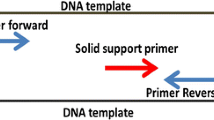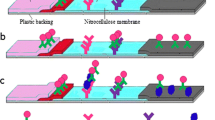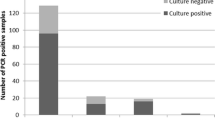Abstract
A new technique, the Magnetic Immuno PCR Assay (MIPA), has been developed for the detection ofSalmonella. The assay utilizes magnetic particles coated with monoclonal antibodies againstSalmonella to extract these bacteria from the sample. Trapped bacteria are lysed, and the supernatant, which contains bacterial DNA, is then subjected to the polymerase chain reaction (PCR) using primers from theSalmonella typhimurium origin of DNA replication to amplify a 163 bp region. The specificity of the primer set was tested in the PCR; amplification occurred with all 25Salmonella strains tested but not with 19 other species ofEnterobacteriaceae tested. A sensitivity of 100 cfuSalmonella typhimurium was achieved for the MIPA by visualization of the amplified products by ethidiumbromide stained agarose gel electrophoresis. A tenfold higher sensitivity was obtained by Southern blotting of the amplified products. The presence of 107 cfuEscherichia coli did not interfere with these detection levels. The MIPA thus specifically detected 100 cfu ofSalmonella within 5 h and may be potentially useful for rapid detection ofSalmonella in clinical specimens and food.
Similar content being viewed by others
References
Helrich K (ed Official methods of analysis. Association of Official Analytical Chemists, Arlington, VA, 1990, p. 467–492.
Van Leusden FM, van Schothorst M, Beckers HJ The standardSalmonella isolation method. In: Corry JEL, Roberts D, Skinner FA (ed): Isolation and identification methods for food poisoning organisms. Academic Press, London, 1982, p. 35–49.
Krysinski EP, Heimsch RC Use of enzyme-labeled antibodies to detectSalmonella in foods. Applied and Environmental Microbiology 1977, 33: 947–954.
Eckner KF, Flowers RS, Robison BJ, Mattingly JA, Gabis DA, Silliker JH Comparison ofSalmonella Bio-Enza Bead immunoassay method and conventional culture procedure for detection ofSalmonella in foods. Journal of Food Protection 1987, 50: 379–385.
Van Poucke LSG Salmonella-TEK, a rapid screening method forSalmonella species in food. Applied and Environmental Microbiology 1990, 56: 924–927.
Araj GF, Das Chugh T Detection ofSalmonella spp. in clinical specimens by capture enzyme-linked immunosorbent assay. Journal of Clinical Microbiology 1987, 25: 2150–2153.
Fitts R, Diamond M, Hamilton C, Neri M DNA-DNA hybridization assay for detection ofSalmonella spp. in foods. Applied and Environmental Microbiology 1983, 46: 1146–1151.
Gopo JM, Melis R, Filipska E, Meneveri R, Filipski J Development of aSalmonella-specific biotinylated DNA probe for rapid routine identification ofSalmonella. Molecular and Cellular Probes 1988, 2: 271–279.
Scholl DR, Kaufmann C, Jollick JD, York CK, Goodrum GR, Charache P Clinical application of novel sample processing technology for the identification of salmonellae by using DNA probes. Journal of Clinical Microbiology 1990, 28: 237–241.
Saiki RK, Gelfand DH, Stoffel S, Sharf SJ, Higuchi R, Horn GT, Mullis KB, Erlich HA Primer-directed enzymatic amplification of DNA with a thermostable DNA polymerase. Science 1988, 239: 487–491.
Allard A, Girones R, Juto P, Wadell G Polymerase chain reaction for detection of adenoviruses in stool samples. Journal of Clinical Microbiology 1990, 28: 2659–2667.
Birkmeyer RC, Diaco R, Hutson DK, Lau HP, Miller WK, Neelkantan NV, Pankratz TJ, Tjeng SY, Vickery DR, Yang EK Application of novel chromium dioxide magnetic particles to immunoassay development. Clinical Chemistry 1987, 33: 1543–1547.
Kornberg A Supplement to DNA replication. W.H. Freeman, San Fransisco, 1982, p. 145–152.
Zyskind JW, Cleary JM, Brusilow WSA, Harding NE, Smith DW Chromosomal replication origin from the marine bacteriumVibrio harveyi functions inEscherichia coli: oriC consensus sequence. Proceedings of the National Academy of Sciences of the USA 1983, 80: 1164–1168.
Maniatis T, Fritch EF, Sambrook J Molecular cloning: a laboratory manual. Cold Spring Harbor Laboratory, Cold Spring Harbor, NY, 1982.
Author information
Authors and Affiliations
Rights and permissions
About this article
Cite this article
Widjojoatmodjo, M.N., Fluit, A.C., Torensma, R. et al. Evaluation of the Magnetic Immuno PCR assay for rapid detection ofSalmonella . Eur. J. Clin. Microbiol. Infect. Dis. 10, 935–938 (1991). https://doi.org/10.1007/BF02005447
Issue Date:
DOI: https://doi.org/10.1007/BF02005447




